Top 3 Things You’ll Learn
- Questions to help employers and their members understand and plan for the COVID-19 vaccine
- How employer-sponsored plans are expected to handle COVID-19 vaccine administration
- Resources on COVID-19 vaccine rollout requirements and vaccine dose tracking by state
There is an overwhelming amount of information from various sources on the COVID-19 vaccine, with limited details on the implications for employers. For non-hospital employers, it’s a waiting game as the vaccine rollout gets to the general public. However, there are critical questions and concerns employers are thinking about now. This article combines several authoritative sources to highlight some of the key points to consider and includes links to helpful resources. It’s intended to help brokers effectively consult with employers on what the vaccine means for their business, their member population, and their pharmacy benefits program.
FDA Vaccine Authorization
The U.S. Food and Drug Administration (FDA) has a review process to issue Emergency Use Authorizations (EUA) before vaccines are authorized for use by the general public. Pfizer’s Messenger RNA vaccine was approved by the FDA for EUA on Friday, December 11, 2020. Moderna’s Messenger RNA vaccine was approved by the FDA for EUA on Friday, December 18, 2020. There are several COVID-19 vaccines in late-stage clinical development in the U.S. and globally. Upon receiving FDA authorization, initial doses of the vaccine will be shipped within 24 hours, and immunizations could begin within about 48 hours. The Washington Post created a vaccine tracker that provides information on how many doses of the vaccine are being sent to each state.
It’s important to note that neither vaccine has been approved for pregnant women or children. Children were purposely excluded from initial clinical trials to date, which is standard protocol for vaccine development until safety and efficacy can be adequately assessed in adults first. It’s estimated that results from trials in children won’t be available until mid-to-late 2021.
Additionally, vaccines are intended to prevent the vaccinated person from getting sick and do not prevent them from spreading the virus to others. This means that even a vaccinated person who contracts COVID-19 still is contagious, which is especially important to remember in workplace situations where some people are vaccinated and others aren’t. It’s recommended that all people stay cautious and continue to wear masks, practice frequent hand-washing, and socially distance until at least a majority of the population is vaccinated.
COVID-19 Vaccine Administration & Payment Protocols
During the initial phase of limited vaccine supply, the federal government is planning to purchase all the initial supply of the vaccine and allocate vaccines to the states for prioritized distribution. The Coronavirus Aid, Relief, and Economic Security (CARES) Act authorized federal funding to cover the ingredient cost of the COVID-19 vaccine. Part of the federal mandate requires that members be able to obtain the vaccine at both in-network and out-of-network pharmacies. This means that both fully insured and self-insured pharmacy benefits plans will be required to pay for the administration of the vaccine.
During this time, pharmacy benefits administration fees are expected to align with or near the published reimbursement rates from Medicare Fee for Service: around $17 for the initial dose and $28/$29 for the second dose. For one-dose vaccines, it would be around the $28 price point. One PBM stated they plan to put the COVID-19 vaccine under the pharmacy vaccination program, along with the yearly flu vaccine. For that program, there would be a $0 ingredient cost, but plans would see a typical vaccine admin fee of $20 plus a dispensing fee for it.
PBMs are working with NCPDP to set up benefits and process claims under the pharmacy benefit that meet the NCPDP guidelines, which are published in the NCPDP Emergency Preparedness Guidelines. There are currently two NDCs for vaccines to facilitate immediate distribution of COVID-19 vaccines; these will adjudicate as brand medications. Consistent with current vaccine strategy, COVID-19 vaccines are not rebate eligible and are not included in the calculation of rebate guarantees.
Did you know? The COVID-19 vaccine does not prevent the virus from spreading, employers must provide the vaccine at no-cost to members, and mandates vary by state. These and other critical points should be discussed now within your organization to help ensure a safe and successful return to normal operations.
Further Considerations for Employers
There’s no doubt that the next several months will be trying, and the vaccine roll-out schedule will be confusing. Each organization, beyond just the HR team, is going to have to make tough decisions for their business, their company culture, and their employees. They’ll have to decide how to get their people back to work safely and appropriately. Employers will be looking for support and advice, and wondering how other employers are approaching their handling of the vaccine for their employee populations.
Here are several considerations worth discussing with your clients to ensure they are prepared for what’s to come in the next phase of vaccine discussion:
- Will a vaccine be mandated for people in your state? At the end of October, each state was required to submit to the CDC their own roadmap of their vaccine plan, including distribution, prioritization, and mandates. In some states, such as Virginia for example, the Health Commissioner has authority to mandate immunizations during a public health crisis if a vaccine is available. Employers will be able to set up benefits to meet the applicable regulations, and so employers should be aware of requirements in their particular state.
- Will you mandate a vaccine for employees in certain job functions? Employers also are seeking clarification as to what the vaccine means for their industry to open up as well as the implications for specific roles. Will airlines require employees and travelers to get the vaccine? Will proof of a vaccine be required to attend indoor events? Ticketmaster has mentioned this as a possibility recently to attend concerts, for example.
- How will you continue to protect unvaccinated employees? Because vaccines don’t prevent the spread of viruses, vaccinated employees still are contagious if they contract COVID-19. It is wrong to assume that things can resume to pre-COVID operations until a large majority of the general population is vaccinated. High-risk employees who choose not to vaccinate, those who are allergic, and women who are pregnant remain at risk of exposure. Workplace precautions must be maintained for their protection.
- How will you overcome vaccine hesitancy in your workforce? Vaccine hesitancy refers to a person’s delay in acceptance or refusal of vaccination despite availability of vaccination services. Despite the toll COVID-19 has taken, many people in the U.S. are concerned about a vaccine. Being cognizant of employee concerns is important to be able to address them in a timely and appropriate manner.
- How will you balance vaccination costs with other benefits-related costs? The COVID-19 vaccine will be managed in a similar manner to other preventative vaccines. In general, clients can choose to cover the administration cost through their medical and/or PBM pharmacy benefit. As established in the CARES Act, patients are to receive the vaccine at no out-of-pocket cost and no deductible, regardless of where they get the vaccine. Employer Group Waiver Plans (EGWPs) are able to allow coverage for the administration fees but would incur additional financial risk.
- What communication and outreach will you do to support member adherence to the second vaccine dose? Some PBMs and retail pharmacies are planning multi-pronged communications that include email, IVR, and text messaging to remind members about their second dose appointments. Employers should determine how they will support those efforts and relay messages using their established communication channels.
As we look forward, it’s on all of us to try to be an advocate and resource for employers so that we can support them in a new and different way. This includes giving careful consideration to the points discussed above, as well as delivering innovative ways to address the prescription drug cost challenges they already were facing. 2021 will be a defining year for many HR leaders, and we are in prime position to help them achieve the cost savings and member experience they want and need.



